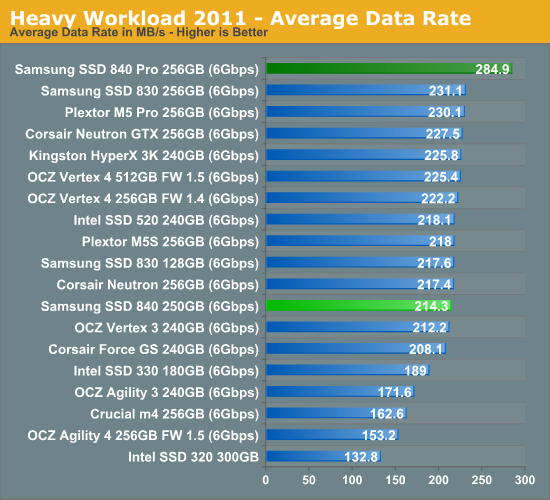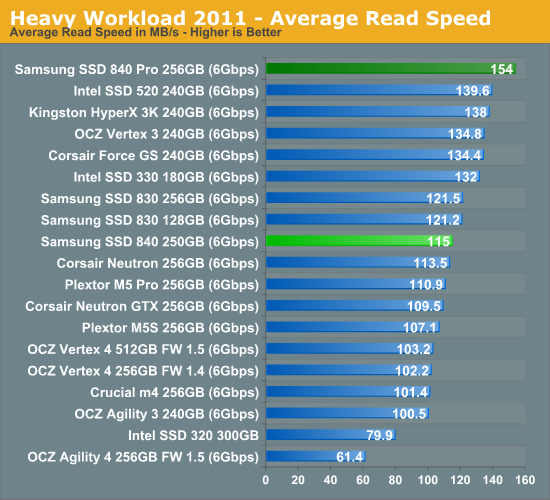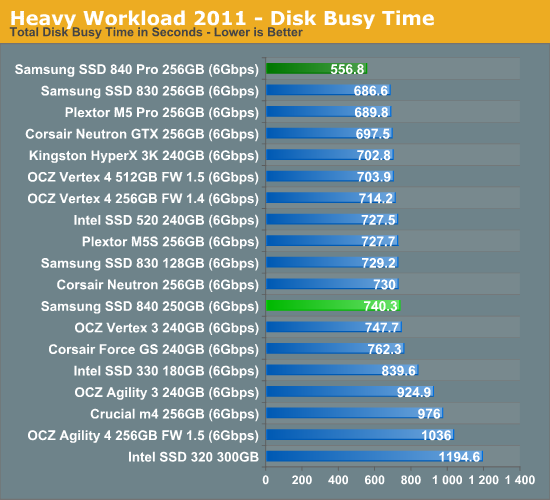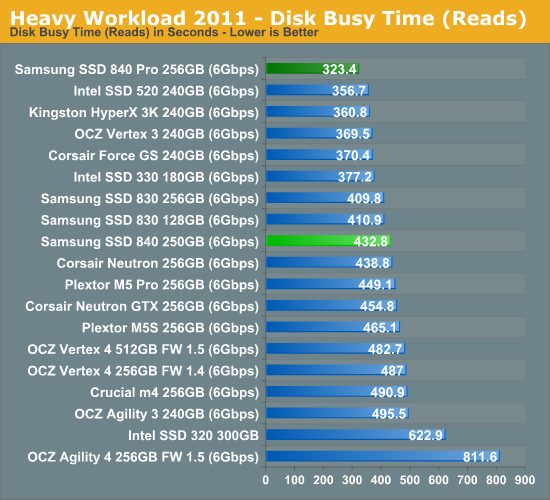Samsung SSD 840 (250GB) Review
by Kristian Vättö on October 8, 2012 12:14 PM EST- Posted in
- Storage
- SSDs
- Samsung
- TLC
- Samsung SSD 840
AnandTech Storage Bench 2011
Last year we introduced our AnandTech Storage Bench, a suite of benchmarks that took traces of real OS/application usage and played them back in a repeatable manner. Anand assembled the traces out of frustration with the majority of what we have today in terms of SSD benchmarks.
Although the AnandTech Storage Bench tests did a good job of characterizing SSD performance, they weren't stressful enough. All of the tests performed less than 10GB of reads/writes and typically involved only 4GB of writes specifically. That's not even enough exceed the spare area on most SSDs. Most canned SSD benchmarks don't even come close to writing a single gigabyte of data, but that doesn't mean that simply writing 4GB is acceptable.
Originally we kept the benchmarks short enough that they wouldn't be a burden to run (~30 minutes) but long enough that they were representative of what a power user might do with their system. Later, however, we created what we refer to as the Mother of All SSD Benchmarks (MOASB). Rather than only writing 4GB of data to the drive, this benchmark writes 106.32GB. This represents the load you'd put on a drive after nearly two weeks of constant usage. And it takes a long time to run.
1) The MOASB, officially called AnandTech Storage Bench 2011—Heavy Workload, mainly focuses on the times when your I/O activity is the highest. There is a lot of downloading and application installing that happens during the course of this test. Our thinking was that it's during application installs, file copies, downloading, and multitasking with all of this that you can really notice performance differences between drives.
2) We tried to cover as many bases as possible with the software incorporated into this test. There's a lot of photo editing in Photoshop, HTML editing in Dreamweaver, web browsing, game playing/level loading (Starcraft II and WoW are both a part of the test), as well as general use stuff (application installing, virus scanning). We included a large amount of email downloading, document creation, and editing as well. To top it all off we even use Visual Studio 2008 to build Chromium during the test.
The test has 2,168,893 read operations and 1,783,447 write operations. The IO breakdown is as follows:
| AnandTech Storage Bench 2011—Heavy Workload IO Breakdown | ||||
| IO Size | % of Total | |||
| 4KB | 28% | |||
| 16KB | 10% | |||
| 32KB | 10% | |||
| 64KB | 4% | |||
Only 42% of all operations are sequential; the rest ranges from pseudo to fully random (with most falling in the pseudo-random category). Average queue depth is 4.625 IOs, with 59% of operations taking place in an IO queue of 1.
Many of you have asked for a better way to really characterize performance. Simply looking at IOPS doesn't really say much. As a result we're going to be presenting Storage Bench 2011 data in a slightly different way. We'll have performance represented as Average MB/s, with higher numbers being better. At the same time we'll be reporting how long the SSD was busy while running this test. These disk busy graphs will show you exactly how much time was shaved off by using a faster drive vs. a slower one during the course of this test. Finally, we will also break out performance into reads, writes, and combined. The reason we do this is to help balance out the fact that this test is unusually write intensive, which can often hide the benefits of a drive with good read performance.
There's also a new light workload for 2011. This is a far more reasonable, typical every day use case benchmark. It has lots of web browsing, photo editing (but with a greater focus on photo consumption), video playback, as well as some application installs and gaming. This test isn't nearly as write intensive as the MOASB but it's still multiple times more write intensive than what we were running last year.
We don't believe that these two benchmarks alone are enough to characterize the performance of a drive, but hopefully along with the rest of our tests they will help provide a better idea. The testbed for Storage Bench 2011 has changed as well. We're now using a Sandy Bridge platform with full 6Gbps support for these tests.
AnandTech Storage Bench 2011—Heavy Workload
We'll start out by looking at average data rate throughout our new heavy workload test:

The 840 is quite average in our Heavy suite and performs similarly to most SandForce drives. The 840 Pro is a lot faster under heavy workloads, so it should be obvious by now why Samsung is offering two SSDs instead of one like they used to.


The next three charts just represent the same data, but in a different manner. Instead of looking at average data rate, we're looking at how long the disk was busy for during this entire test. Note that disk busy time excludes any and all idles, this is just how long the SSD was busy doing something:













86 Comments
View All Comments
SSDFDE - Wednesday, November 14, 2012 - link
... actually what happens if I set the IDE (sorry, its ATA actually) password in BIOS and then move the drive to another computer with no ATA HDD BIOS password set? Will it be readable there as the internal key in the drive of course still is the same?As ATA password is an option only, and setting the ATA password does not alter the internal SSD key, the actual encryption on the drive does not change at all no matter if a ATA password is set or not, right?
BTW: Resetting / generating an new internal key seems to be done with "secure erase" on hardware-encrypted drives with internal encryption key... clearly then its only bitshit on the dive once the old key is lost. Is there an option to do that an the Samsung drive anyway?
JellyRoll - Saturday, November 24, 2012 - link
Digital Signal Processing has nothing to do with the voltage states of the NAND. It is processing of the actual signal that comes from the NAND packages.DSP is used for multiple technologies, from audio to video to radar. These devices do not utilize nand, and DSP has zero interaction with the NAND itself, it merely reduces and corrects the amount of errors that come from the NAND.
here is a primer on DSP: http://www.analog.com/en/content/beginners_guide_t...
There needs to be more research before these incorrect explanations are posted.
"Even though DSP doesn't make NAND immortal, it causes a lot less stress on the NAND, allowing it to last for more P/E cycles than what you would get without DSP."--This statement is entirely untrue, as DSP has no interaction with the NAND itself. It seems there is a bit of guesswork going on when writing this article.
DSP simply corrects errors. With lower endurance NAND you experience more errors.
PanzerIV88 - Thursday, December 27, 2012 - link
I just bought on Boxing Day that Samsung 840 250Gb for 150$ + Taxes. The sequential write speed is what scares the most but other than marketing bs it's actualy what's the less important. There's much more happening into the small files or reading speed which it shines in. I'll definitely replace my Vertex 4 128Gb which isn't as amazing as I thought it was, mostly since I learned that once it reaches 50% capacity, it turns into storage mode instead of performance and the write speed falls of 2 to 3x!!! I can confirm this with benchs I've done, it's really sad..Also thought of doing a Vertex 4 Raid 0 but other than bragging with bench numbers, seriously wtf does 600-800Mb/s is gonna do for a daily light load or gaming?! Totaly nothing more... so I'll save my money.
sriggins - Saturday, March 16, 2013 - link
I have been using an 830 in my MacBook Pro since last October. I use FileVault 2 and do a ton of compiling on the drive. Performance has been steady. How does using OS X encryption affect the life of the drive? Is there any way to tell how many writes have been done so far?brainfuck - Wednesday, July 3, 2013 - link
Is there any way to find the Erase Block Size of Samsung 840 250GB?so that i can align my disk accordingly
thanks
WildBillvms - Wednesday, May 21, 2014 - link
Great Drive , but if you have memory problems click here ----> http://www.billatkinson.net/evo